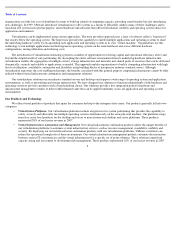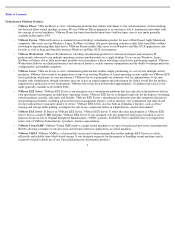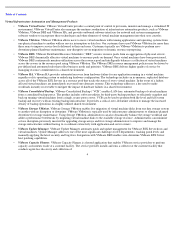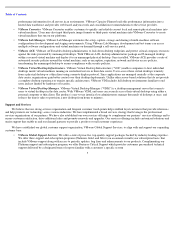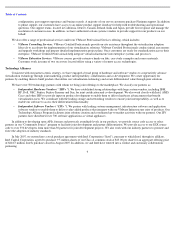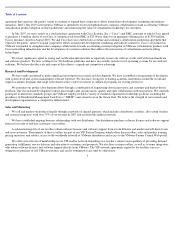VMware 2007 Annual Report Download - page 16
Download and view the complete annual report
Please find page 16 of the 2007 VMware annual report below. You can navigate through the pages in the report by either clicking on the pages listed below, or by using the keyword search tool below to find specific information within the annual report.
Table of Contents
features to their virtualization products similar to features that presently differentiate our product offerings from theirs. Many of our current or
potential competitors also have longer operating histories, greater name recognition, larger customer bases and significantly greater financial,
technical, sales, marketing and other resources than we do. This competition could result in increased pricing pressure and sales and marketing
expenses, thereby materially reducing our profit margins, and could harm our ability to increase, or cause us to lose, market share. Increased
competition also may prevent us from entering into or renewing service contracts on terms similar to those that we currently offer.
Some of our competitors and potential competitors supply a wide variety of products to, and have well-established relationships with, our
current and prospective end users. Some of these competitors have in the past and may in the future take advantage of their existing relationships
to engage in business practices that make our products less attractive to our end users. For example, Microsoft has implemented distribution
arrangements with x86 system vendors and independent software vendors, or ISVs, related to certain of their operating systems that only permit
the use of Microsoft’s virtualization format and do not allow the use of our corresponding format. Microsoft has also recently implemented
pricing policies that require customers to pay additional license fees based on certain uses of virtualization technology. These distribution and
licensing restrictions, as well as other business practices that may be adopted in the future by our competitors, could materially impact our
prospects regardless of the merits of our products. In addition, competitors with existing relationships with our current or prospective end users
could in the future integrate competitive capabilities into their existing products and make them available without additional charge. For
example, Oracle’s announcement promised free server virtualization software intended to support Oracle and non-Oracle applications. By
engaging in such business practices, our competitors can diminish competitive advantages we may possess by incentivizing end users to choose
products that lack the technical advantages of our own offerings.
We also face potential competition from our partners. For example, third parties currently selling our products could build and market their
own competing products and services or market competing products and services of third parties. If we are unable to compete effectively, our
growth and our ability to sell products at profitable margins could be materially and adversely affected.
Industry alliances or consolidation may result in increased competition.
Some of our competitors have made acquisitions or entered into partnerships or other strategic relationships with one another to offer a
more comprehensive virtualization solution than they individually had offered. For example, Citrix Systems recently acquired XenSource, a
developer of virtualization solutions and Microsoft recently announced an expansion of its alliance with Citrix. We expect these trends to
continue as companies attempt to strengthen or maintain their market positions in the evolving virtualization infrastructure industry. Many of the
companies driving this trend have significantly greater financial, technical and other resources than we do and may be better positioned to
acquire and offer complementary products and technologies. The companies resulting from these possible combinations may create more
compelling product offerings and be able to offer greater pricing flexibility than we can or may engage in business practices that make it more
difficult for us to compete effectively, including on the basis of price, sales and marketing programs, technology or product functionality. These
pressures could result in a substantial loss of customers or a reduction in our revenues.
Our operating results may fluctuate significantly, which makes our future results difficult to predict and may result in our operating results
falling below expectations or our guidance, which could cause the price of our Class A common stock to decline.
Our operating results may fluctuate due to a variety of factors, many of which are outside of our control. As a result, comparing our
operating results on a period-to-period basis may not be meaningful. Our past results should not be relied upon as an indication of our future
performance. In addition, a significant portion of our quarterly sales typically occurs during the last month of the quarter, which we believe
generally reflects customer buying patterns for enterprise technology. As a result, our quarterly operating results are difficult to predict even
12


